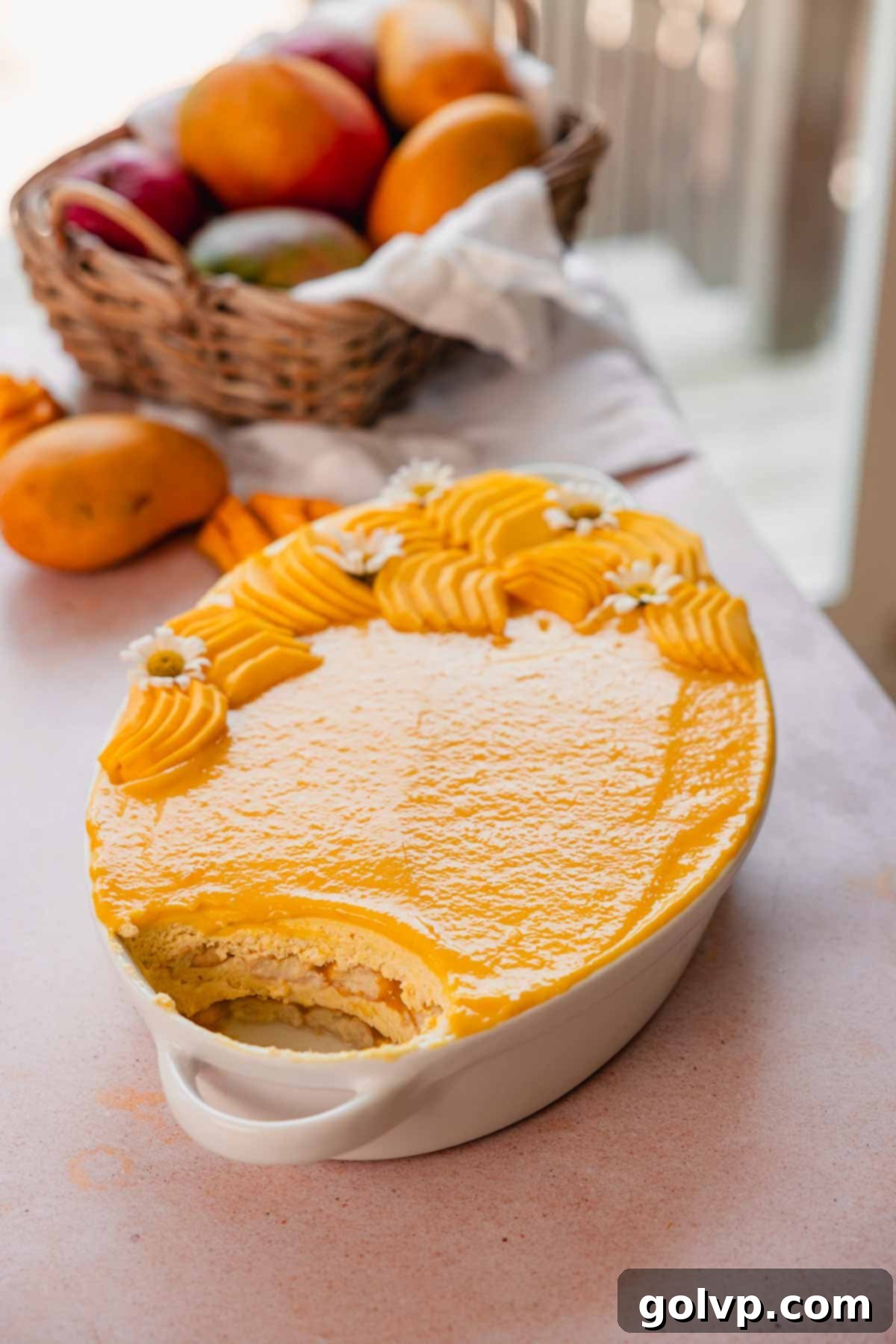Decadent Mango Tiramisu: A Tropical, No-Bake Delight for Summer & Beyond
Prepare to embark on a culinary journey to a tropical paradise with this incredibly rich, luxuriously creamy, and utterly delicious mango tiramisu. Far from your average dessert, this recipe takes the classic Italian favorite and infuses it with the vibrant, sun-kissed flavor of fresh or frozen mangoes. Every spoonful promises a symphony of textures and tastes: delicate ladyfingers soaked in aromatic vanilla milk, luscious layers of sweet mango puree, and an indulgent, mousse-like mascarpone cream, all crowned with a tangy, cooked mango curd. What’s more, you can enjoy this delightful creation without a single worry about raw eggs, as all egg yolks are expertly cooked into the flavorful mango curd, making it a safe and delightful treat for everyone.
This exquisite dessert is the quintessential choice for brightening up your spring and summer gatherings, offering a refreshing escape with its tropical notes. It’s also the perfect way to make the most of those abundant, juicy, in-season mangoes. But don’t despair when mango season ends! This versatile recipe allows for the easy use of frozen mango, ensuring you can whip up this delightful tiramisu and bring a taste of sunshine to your table any time of the year. Whether you’re planning a special occasion or simply craving a unique and unforgettable dessert, this mango tiramisu is guaranteed to impress.
This recipe is in partnership with the mango board.
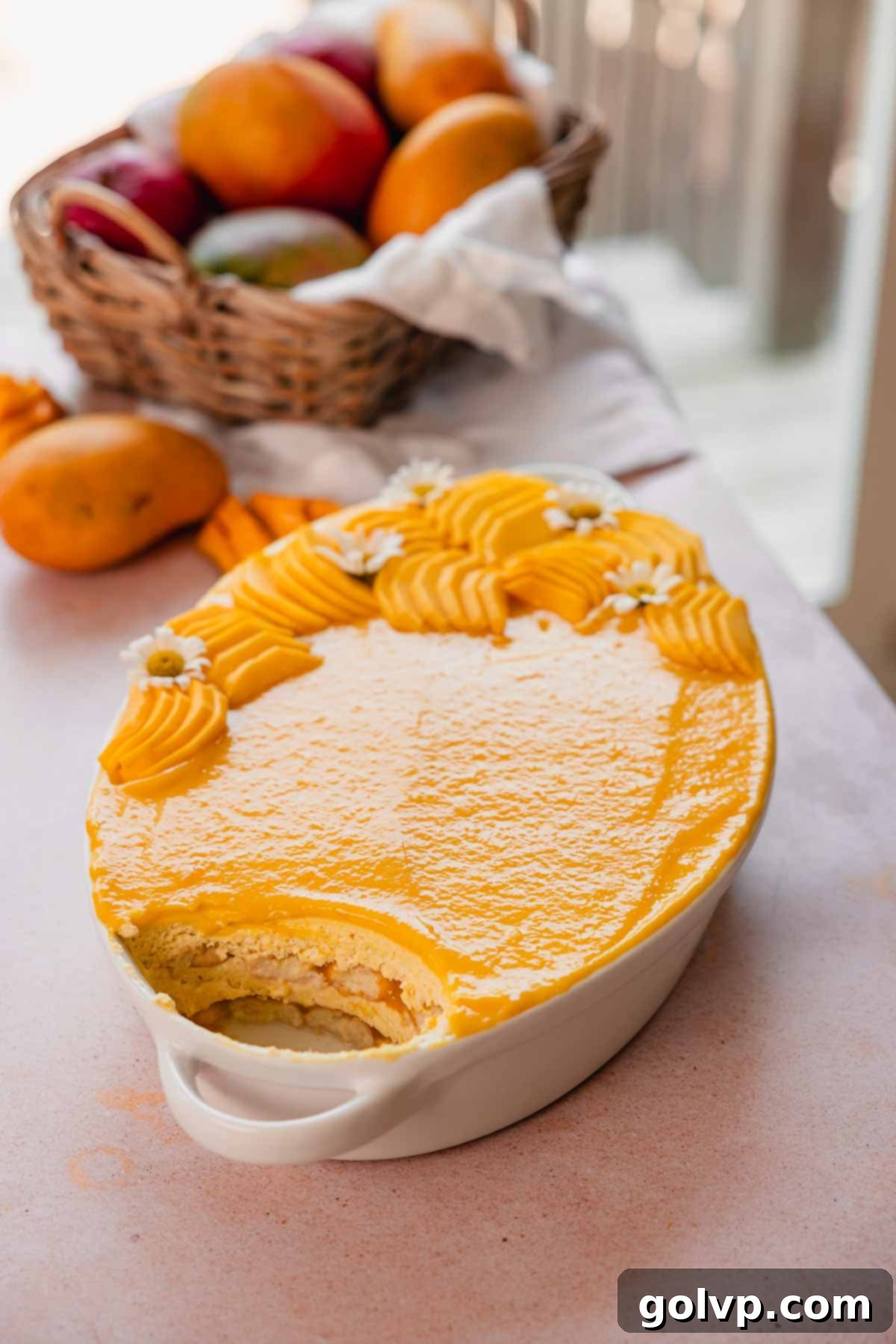
🥭 Why You’ll Absolutely LOVE This Mango Tiramisu Recipe
This mango tiramisu isn’t just another dessert; it’s an experience. Here’s why this tropical twist on a classic will quickly become your new favorite:
- Rich and Tangy Mango Curd: At the heart of this tiramisu is its incredible mango curd. We don’t just add a hint of mango; we fold creamy, tart mango curd directly into the mascarpone filling and use it generously to crown the tiramisu. This double dose ensures an intensely rich and vibrant mango flavor that truly shines through. The cooked egg yolks within the curd lend a familiar depth and luxurious richness, reminiscent of a classic tiramisu’s complexity, but with a bright, fruity twist. This method also safely eliminates any concerns about raw eggs, making it a dessert everyone can enjoy without hesitation.
- Moist Vanilla Milk Ladyfingers: The pairing of mango and milk is a time-honored combination for good reason – it’s simply magical. In this recipe, we elevate the humble ladyfinger by soaking it in a fragrant vanilla milk bath. This infusion creates an exquisitely tender and moist texture that echoes the delightful experience of a mango tres leches cake. You have the flexibility to customize the texture to your preference: for an extra-indulgent, super-moist result, allow the ladyfingers to soak for about 5 seconds until they feel heavy; for a more traditional, subtly moist tiramisu, a brief dip is all that’s needed. Either way, they provide the perfect foundation for the creamy layers.
- A Tiramisu Like No Other: While this recipe beautifully reinvents tiramisu by omitting the traditional coffee and liquor, it remarkably retains all the beloved textures and nuanced flavors that define the classic dessert. You’ll find the signature creamy, milky indulgence from the mascarpone cheese, the familiar richness imparted by cooked egg yolks (skillfully integrated into our mango curd), and an overall ultra-creamy, almost mousse-like fluffy texture. The soft, tender ladyfingers complete the picture. If you’re a devoted fan of traditional tiramisu but are eager to explore a refreshing and exotic variation, this mango tiramisu is undeniably crafted for your palate. It’s a delightful innovation that honors its roots while soaring to new heights of flavor.
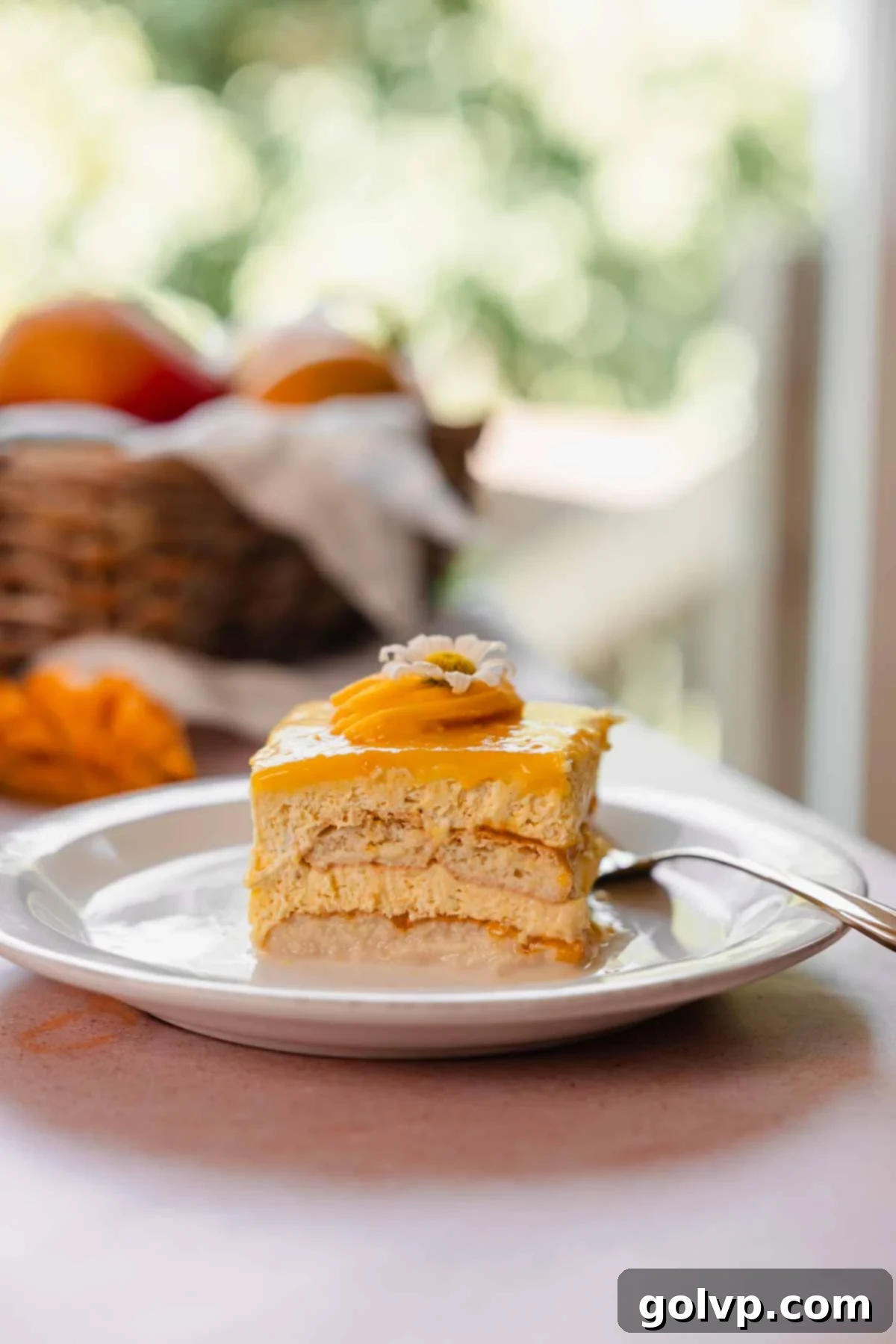
📝 Key Ingredients for Your Mango Tiramisu
Read through for all the tips you will need for success!
Full steps and ingredients in recipe card below.
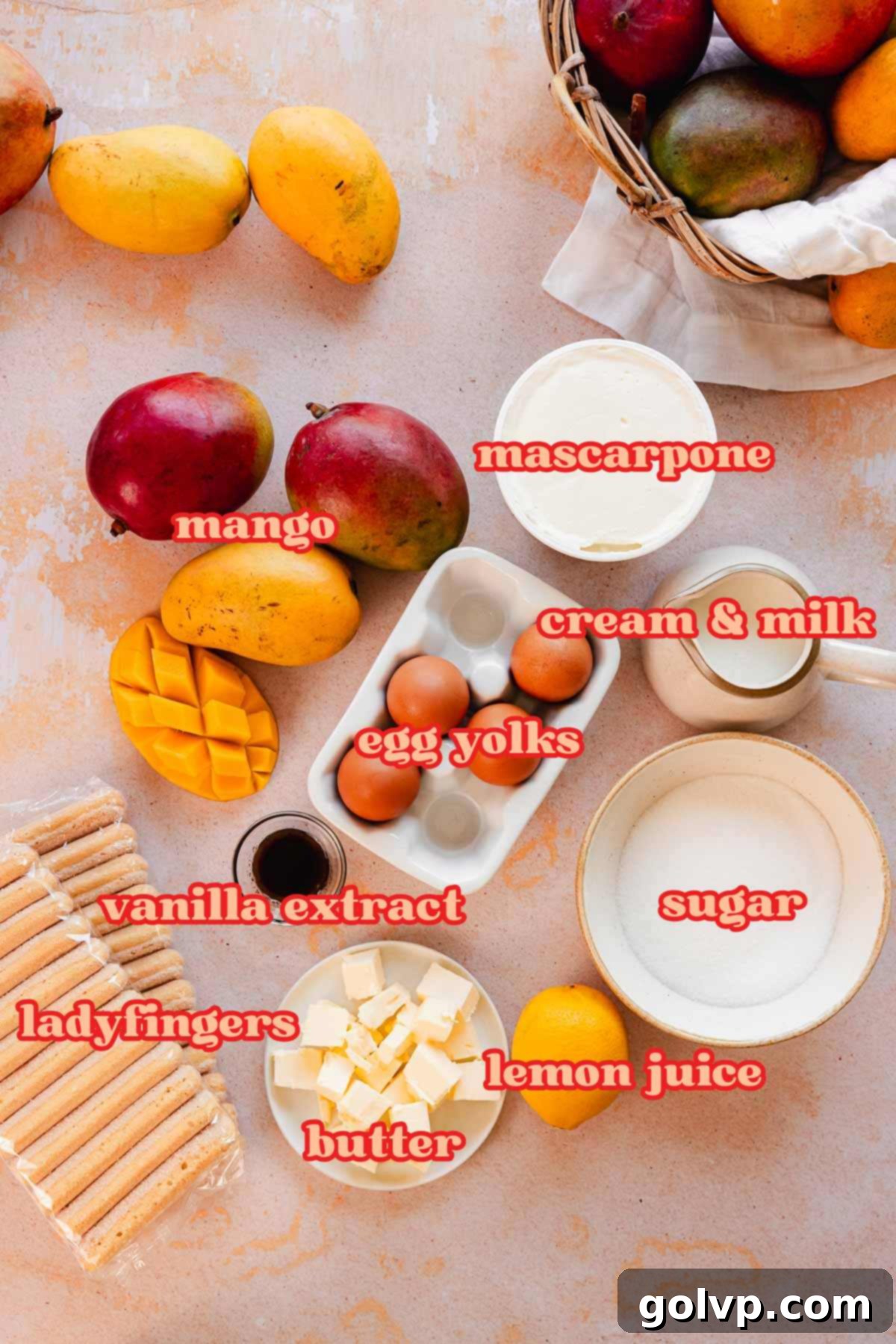
Mango: The star of our show! Both fresh and frozen mangoes are excellent choices for this recipe, offering flexibility so you can enjoy this dessert year-round, regardless of seasonal availability. If opting for fresh mangoes, I highly recommend the Honey (also known as Ataulfo) variety. These smaller mangoes boast an incredibly vibrant, tropical flavor profile that strikes a perfect balance between super sweet and delightfully tart. This inherent sourness is crucial in desserts, as it prevents the final product from being overly sweet, keeping the flavor bright and well-balanced. Kent mangoes are another superb choice due to their notably limited fibrous texture, which makes for a smoother puree. Should you choose Tommy Atkins mangoes, which can be quite fibrous, I strongly advise straining your mango puree to achieve the silky smooth consistency essential for this tiramisu. Avoid using canned mango puree as it often has a very thin, watery texture that will result in a runny mango curd, compromising the overall richness and structure of your dessert.
Lemon: A few tablespoons of freshly squeezed lemon juice are indispensable for the mango curd. The citrus acidity acts as a flavor enhancer, making the natural mango flavor truly “pop” and adding a refreshing tang that cuts through the richness of the dessert.
Egg Yolks: These are critical for creating the luxurious texture and richness of the mango curd. They act as a natural thickener and contribute to the custard-like consistency, imparting a depth of flavor reminiscent of classic tiramisu. While some recipes might call for whole eggs in curds, using only egg yolks prevents an “eggy” taste, ensuring the pure mango flavor remains dominant. This distinction is important for fruit curds like mango, where the fruit’s delicate flavor is paramount, unlike more robust curds such as strawberry or raspberry where whole eggs can sometimes work.
Butter: Unsalted butter is incorporated into the mango curd to add a velvety richness and aid in its thickening process, contributing to a smooth and luxurious mouthfeel. If you only have salted butter on hand, remember to omit any additional salt from the curd recipe to prevent it from becoming too salty and overpowering the sweet-tart mango notes.
Vanilla Extract and Vanilla Bean Paste: You can certainly use either, or both, depending on what you have available and your preference. I personally enjoy using vanilla bean paste in the tiramisu filling because it provides those beautiful, visible specks of vanilla, adding an appealing visual element and a more intense vanilla aroma. For the vanilla milk soak, vanilla extract is ideal as it dissolves and disperses much more effectively throughout the milk than vanilla bean paste would, which might settle at the bottom. The rich, warm notes of vanilla perfectly complement the bright, tropical flavor of the mango.
Heavy Whipping Cream: To achieve a wonderfully airy and stable cream, it’s essential to use heavy whipping cream with a minimum milkfat content of 35%. Anything less than 32% milkfat will likely fail to whip up to the desired stiff peaks, resulting in a runny filling. Always ensure your cream is thoroughly chilled before whipping; cold cream incorporates air much more efficiently, yielding a light and fluffy texture.
Mascarpone Cheese: This is the cornerstone of any authentic tiramisu, and it’s absolutely crucial for achieving the signature rich creaminess in our mango tiramisu filling. Mascarpone is an Italian cream cheese known for its incredibly smooth, mild, and buttery flavor, as well as its high fat content. It contributes to the filling’s luxurious, melt-in-your-mouth texture, setting it apart from other cream cheeses.
Milk: For the vanilla milk soak, whole milk generally yields the best results, providing a rich base that moistens the ladyfingers beautifully. Alternatively, 2% milk can be used if preferred. For an even more pronounced tropical twist, consider experimenting with full-fat coconut milk; its subtle coconut flavor would pair exquisitely with the mango.
Ladyfingers: These delicate, dry, sponge cake biscuits are a classic tiramisu component and serve as the perfect foundation for our dessert. Opting for premade, dried ladyfingers offers a convenient shortcut, making the assembly process quick and easy. They are also sometimes known as Savoiardi biscuits or cookies. Their porous texture is ideal for soaking up the vanilla milk, providing a soft, cake-like layer.
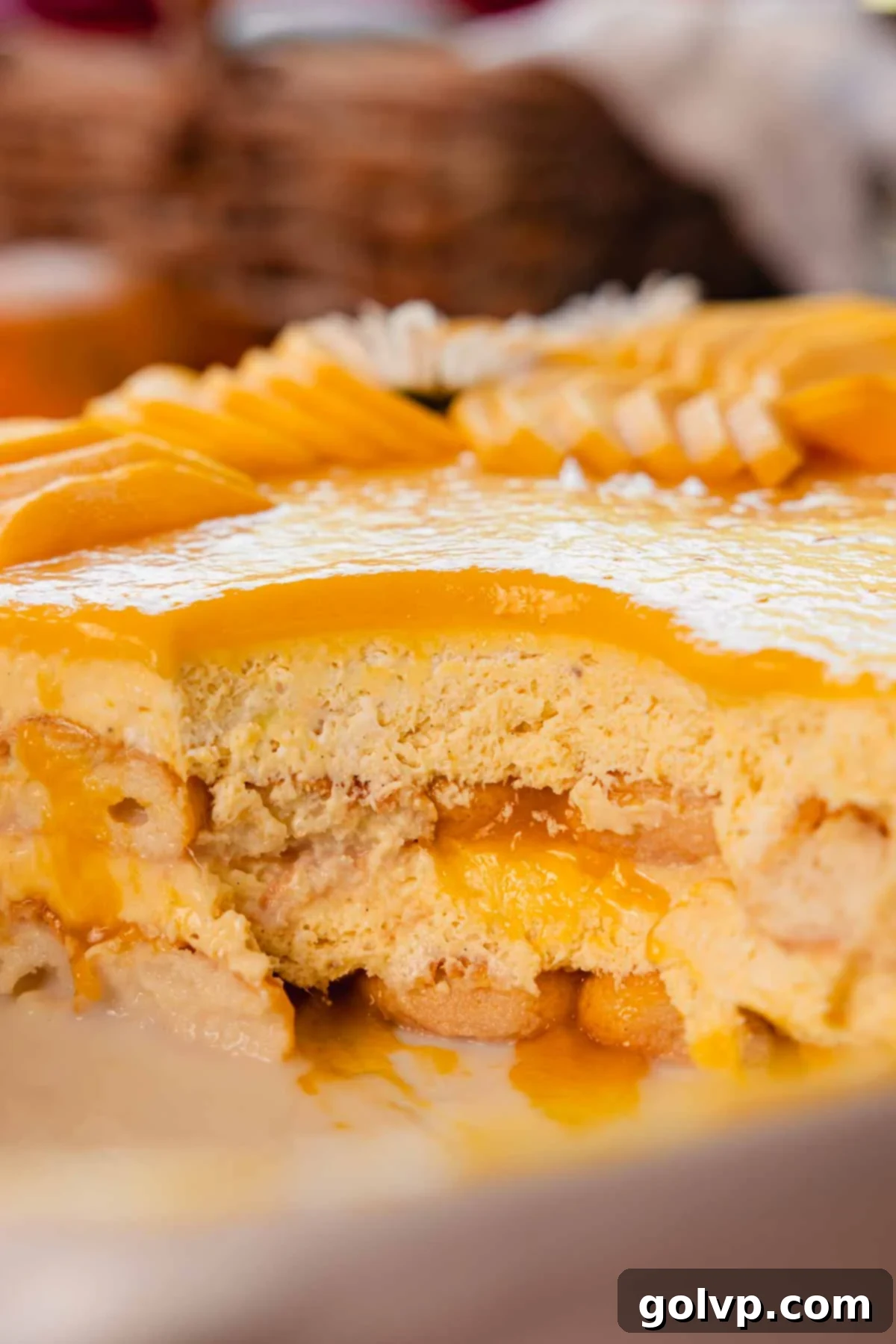
How to Choose Your Mango and Common Mango Varieties
Selecting a perfectly ripe mango is key to the success of this tiramisu. The most reliable method to determine if your mango is ready to eat is to gently press its skin. A ripe mango will yield slightly to pressure, feeling soft to the touch, similar to a ripe avocado or peach. It’s important to note that the color of the mango is not always an indicator of ripeness, as many varieties maintain similar hues whether ripe or unripe. Always rely on the “squeeze test”!
Here are three of the most common and versatile mango varieties you’re likely to find at your local supermarket, along with tips for their ideal use in this recipe:
- Honey (Ataulfo): Distinguished by its bright yellow skin and a uniquely small, kidney-bean shape, the Honey mango offers an unparalleled experience. Its flesh is wonderfully buttery smooth with a firm, non-fibrous texture, making it a joy to eat and process. Flavor-wise, it’s a powerhouse, boasting a bright, intensely tropical sweetness perfectly balanced by a delightful tang. These smaller mangoes are my absolute favorite for crafting both mango curd and other mango-based desserts. Their vibrant, concentrated flavor and natural tartness contribute significantly to a well-rounded and exciting taste profile, ensuring your desserts are never cloyingly sweet.
- Tommy Atkins: Easily recognizable by its striking dark red skin, often accented with shades of green and yellow blush. This variety is known for its firm, juicy flesh, which can be quite fibrous. It offers a sweet, mildly tart flavor with subtle citrus undertones, making it a popular choice for fresh snacking. If you opt to use Tommy Atkins mangoes for your mango curd or puree in this tiramisu, it is highly recommended to strain the blended puree through a fine-mesh sieve. This step will effectively remove any unwanted fibers, guaranteeing a silky-smooth consistency for your dessert.
- Kent: Large and oval-shaped, Kent mangoes typically feature dark green skin with a lovely reddish blush where the sun has kissed them. Inside, you’ll discover a tender, buttery, and incredibly juicy flesh. Their flavor is predominantly sweet, accompanied by a slight sourness and a rich, classic tropical mango essence. What makes Kent mangoes particularly desirable for many culinary applications, including this tiramisu, is their remarkably limited fibrous texture and generous size. This combination makes them an excellent all-purpose variety, perfect for snacking, juicing, drying, and creating smooth purees without much effort.

While these are among the most common varieties available in the USA, the world of mangoes is vast and varied. You can explore even more delightful varieties such as Keitt, Francis, Haden, Alphonse, Edward, Kesar, Manila, and Palmer by visiting Mango.org for comprehensive information and availability guides. Each variety brings its own unique characteristics, offering a spectrum of flavors and textures to discover.
👩🍳 How to Make Mango Tiramisu: A Step-by-Step Guide
Mango Puree Step by Step
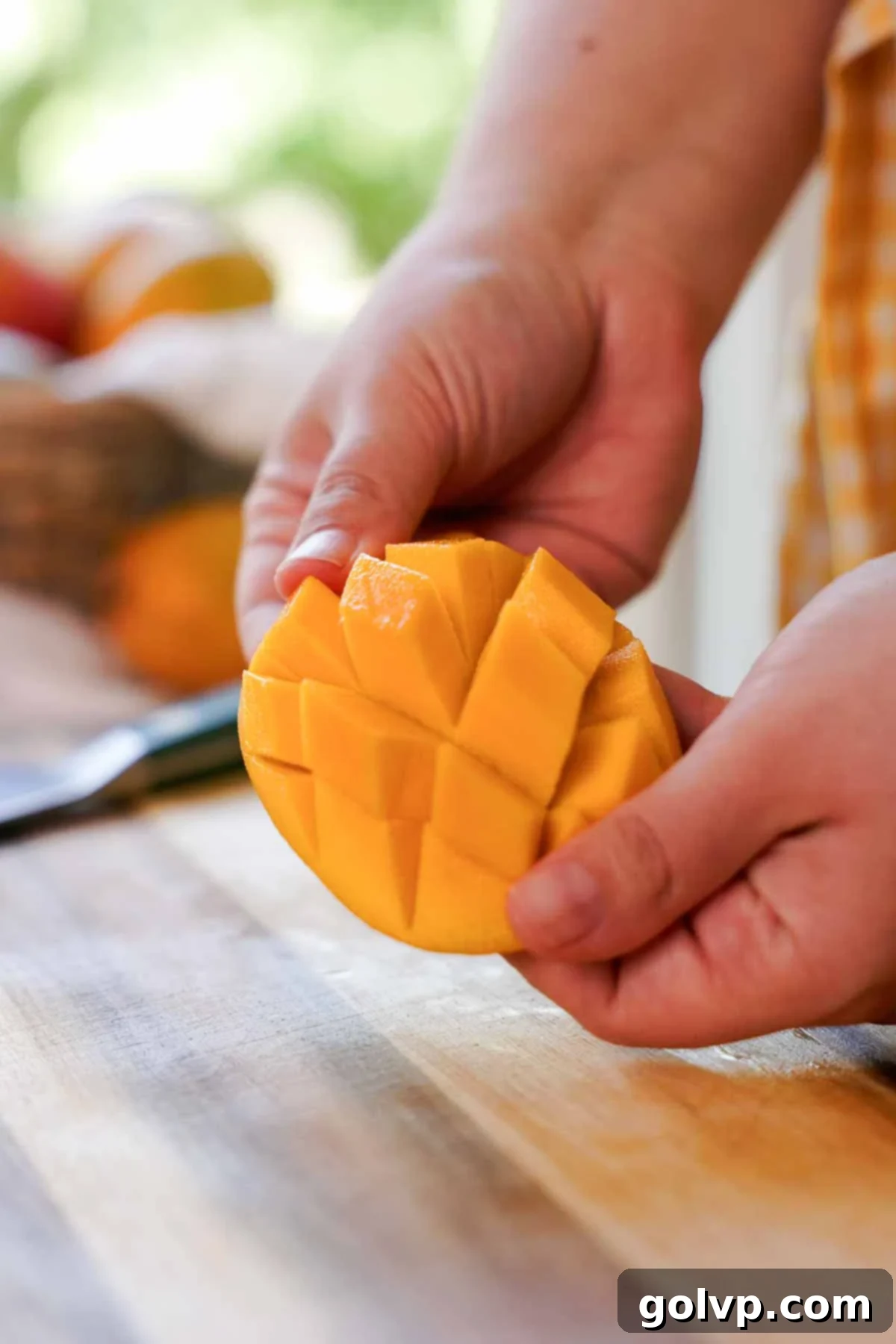
Step 1: To begin, carefully slice along the broad, flat sides of the mango pit, effectively removing the two substantial fleshy cheeks. Take each cheek and gently score the flesh in a precise grid pattern, being mindful not to cut all the way through the skin. Then, with a gentle but firm push from the center of the skin side, turn each mango cheek inside out. This technique neatly exposes the mango cubes, making them incredibly easy to remove.
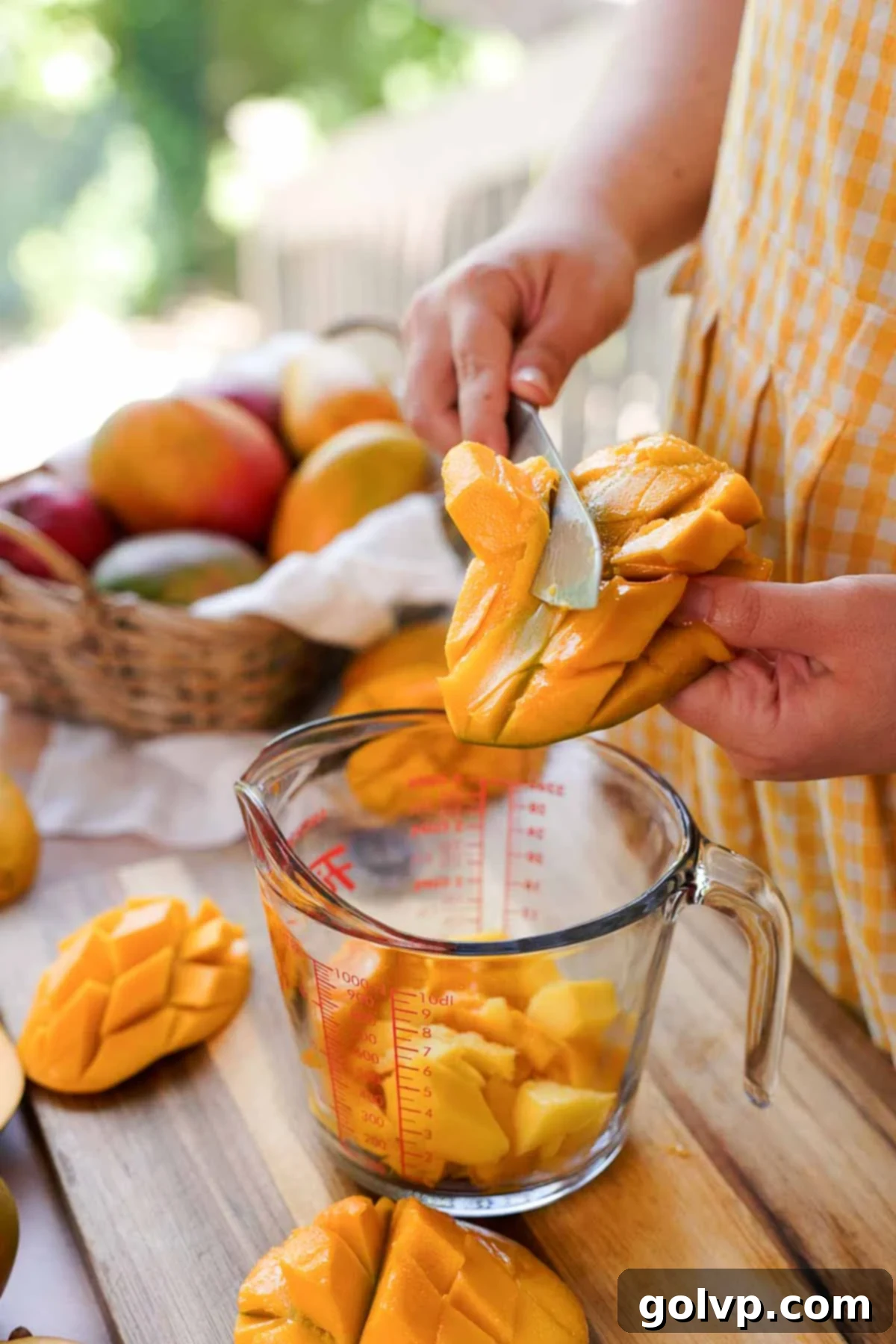
Step 2: Once the cubes are exposed, use a sharp knife to carefully slice them off the skin. Measure out exactly 4 cups of your peeled and cubed mango. Transfer these vibrant mango pieces into a medium-sized saucepan, preparing them for the next stage of transformation into a rich puree.
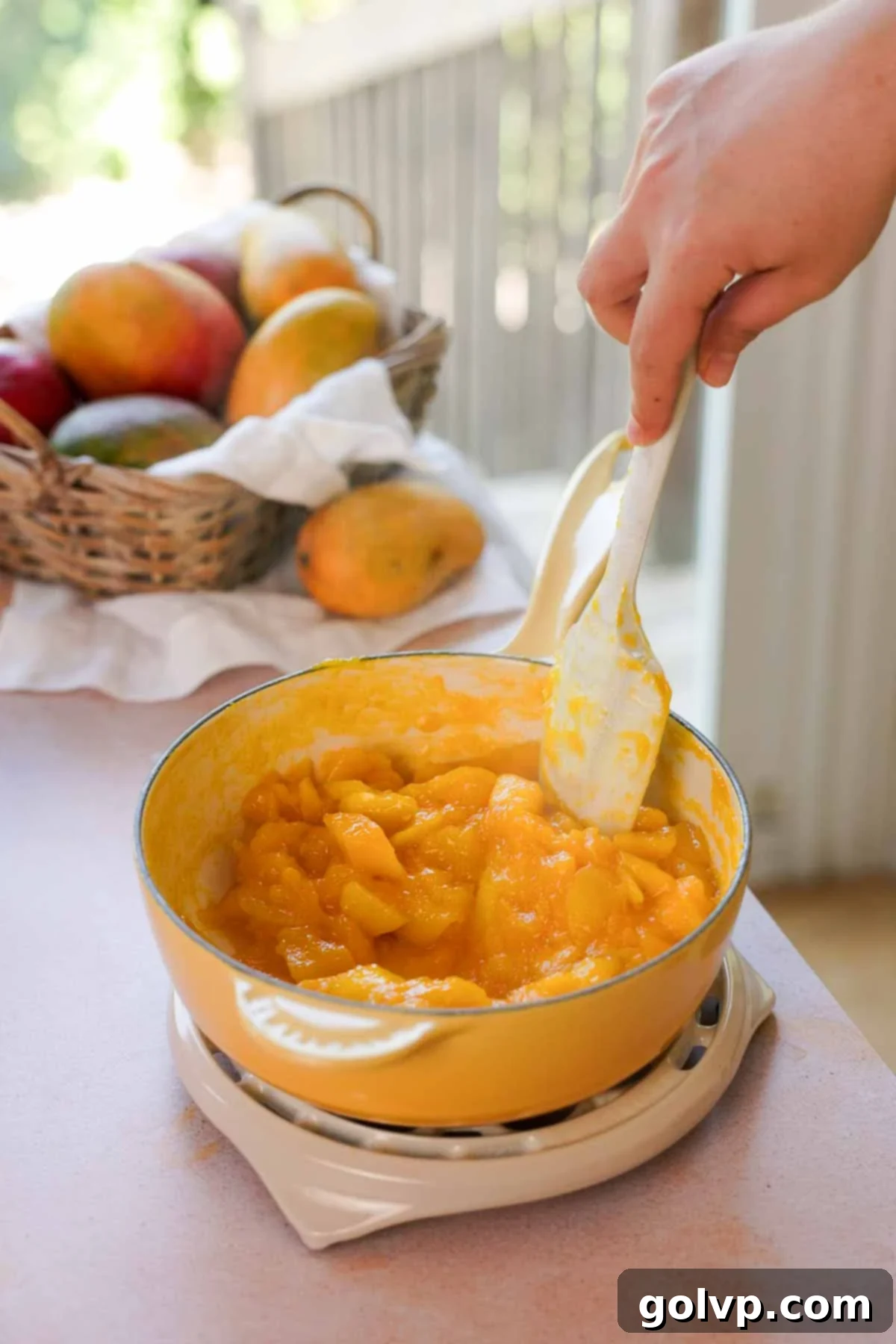
Step 3: To the saucepan containing the mango, add ¼ cup of granulated sugar and ¼ cup of water. Stir these ingredients together until they are well combined. Place the saucepan over medium-low heat and bring the mixture to a gentle simmer. Continue to simmer, stirring frequently to prevent sticking and burning, until the mango mixture visibly thickens to a consistency resembling jam and its color deepens slightly. This process typically takes approximately 10 minutes. At this point, you should have a concentrated and flavorful mango mixture, yielding about 2 cups.
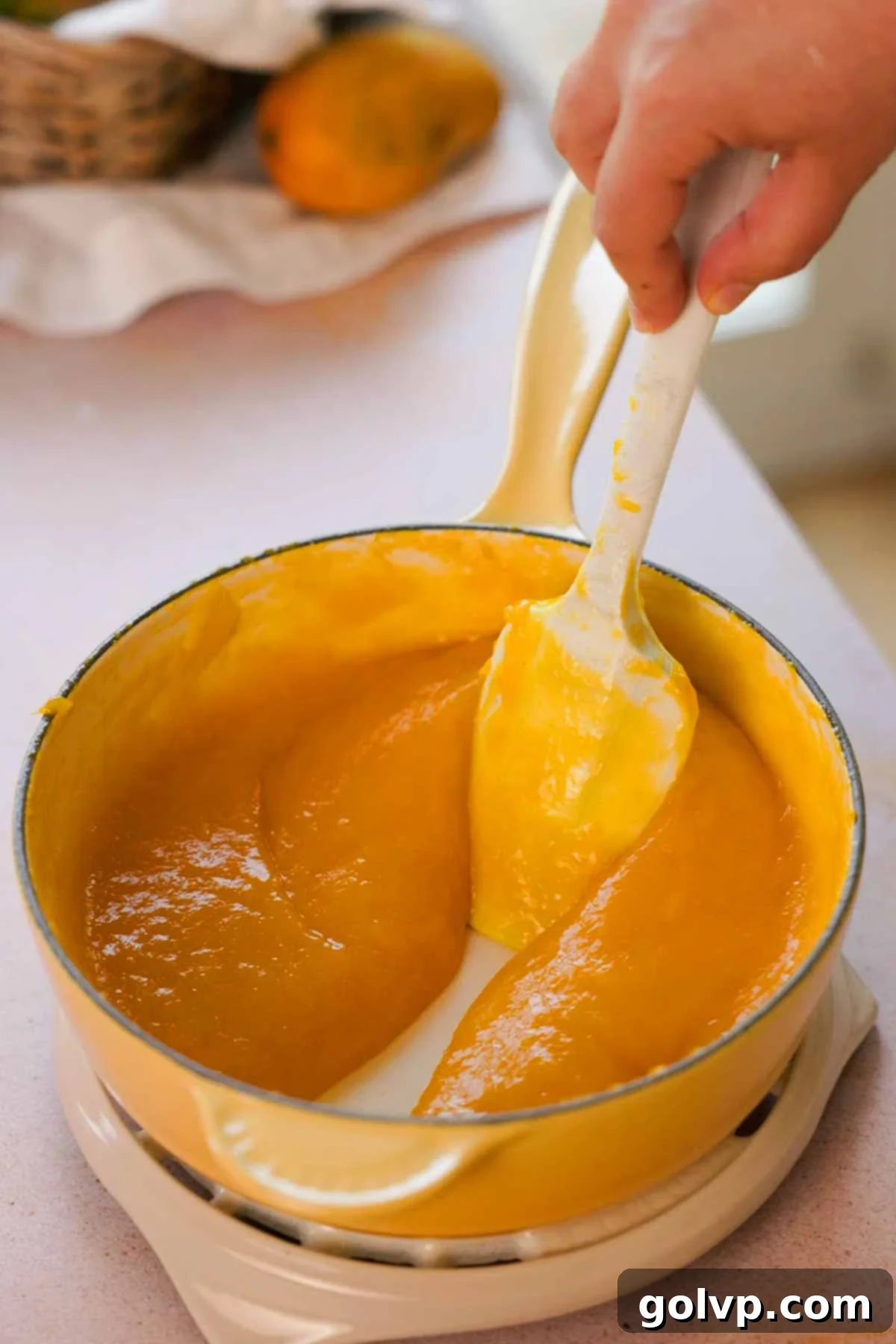
Step 4: Once the mango mixture has cooked down, remove it from the heat. Carefully blend the mango using an immersion blender directly in the saucepan, or transfer it to a smoothie blender or food processor, processing until it achieves a perfectly smooth consistency. If you notice any fibrous strands, especially if using a variety like Tommy Atkins, I highly recommend straining the puree through a fine-mesh sieve to ensure an exceptionally smooth finished product. The reason we blend the mango after cooking is a practical one: blending it beforehand tends to cause the mixture to sputter and splatter considerably during the cooking process, much like tomato sauce. Blending post-cooking makes for a much cleaner and safer experience!
Mango Curd
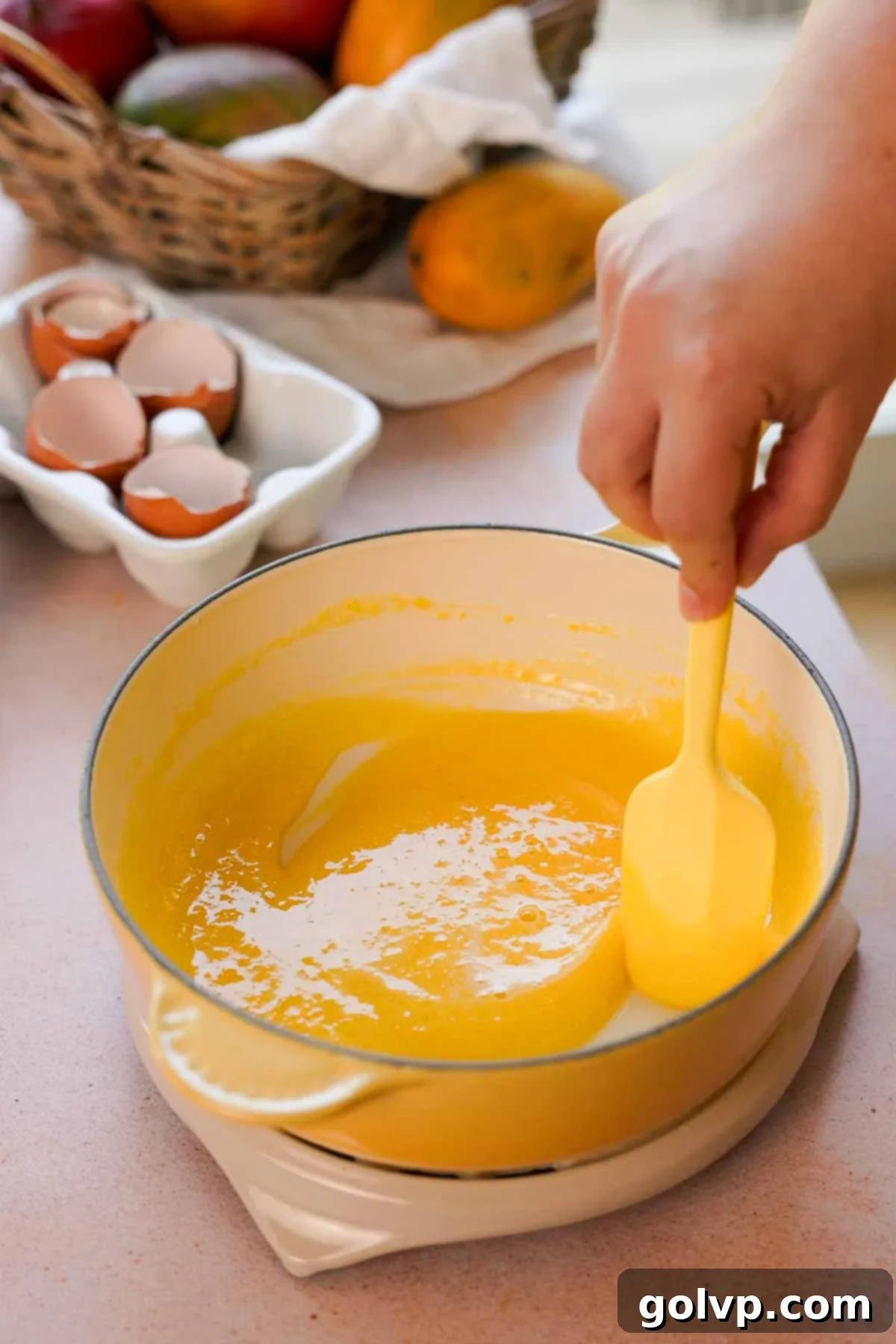
Step 1: In a clean, medium saucepan, combine the egg yolks, granulated sugar, fresh lemon juice, and a pinch of sea salt. Using a whisk, stir these ingredients together vigorously until the mixture is smooth and well incorporated, with no lumps of sugar remaining. This forms the essential base for your tangy mango curd.
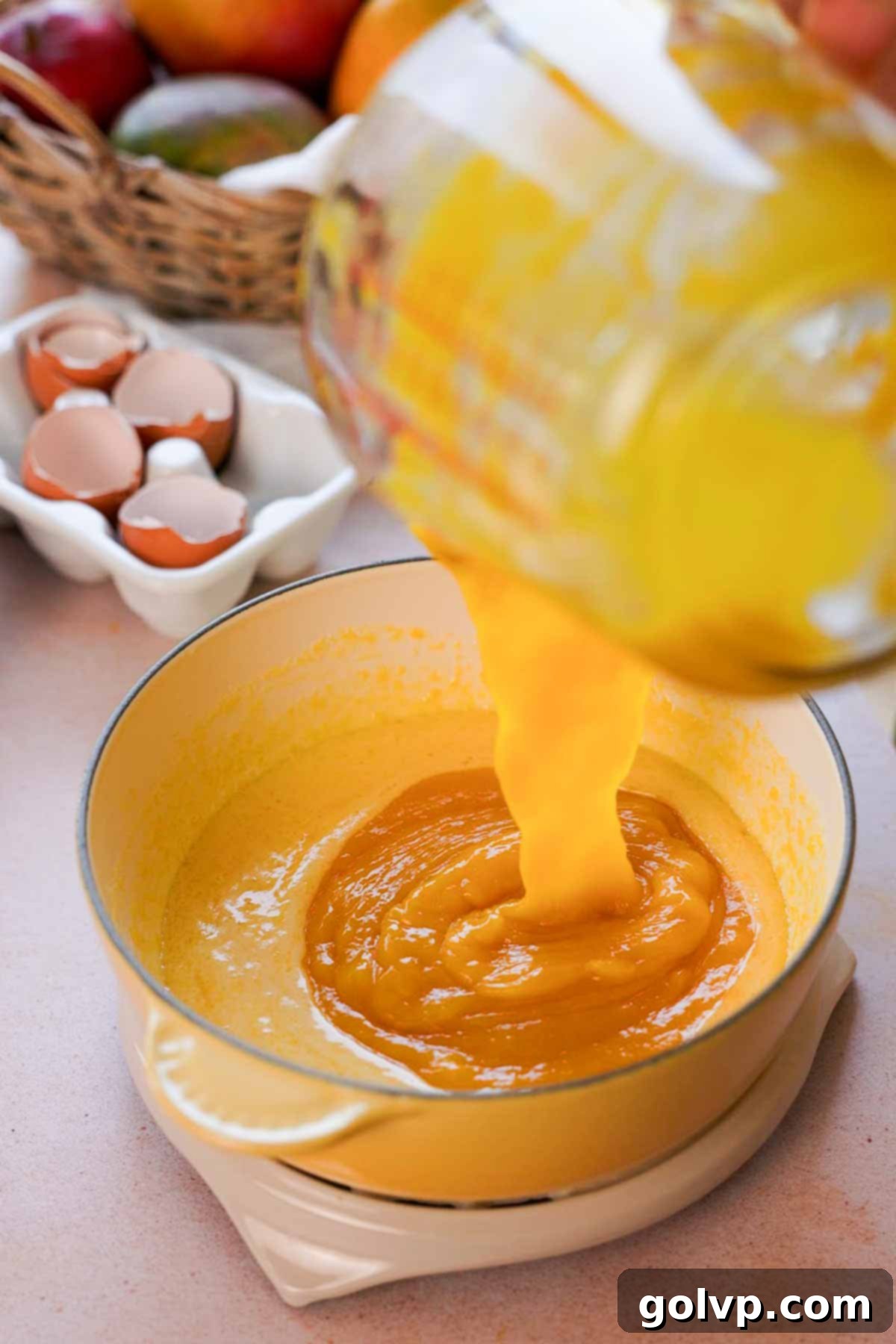
Step 2: Carefully measure out one and a half (1 ½) cups of the prepared mango puree (remember to reserve the remaining half cup of mango puree for a later step in the assembly). Add this measured puree to the saucepan with the egg yolk mixture and stir thoroughly to combine. Place the saucepan over low heat. It is crucial to cook this mixture gently, stirring frequently and consistently to prevent the bottom from burning or the eggs from scrambling. Continue cooking until the curd begins to visibly thicken and small bubbles start to appear around the edges, indicating it is cooked through.
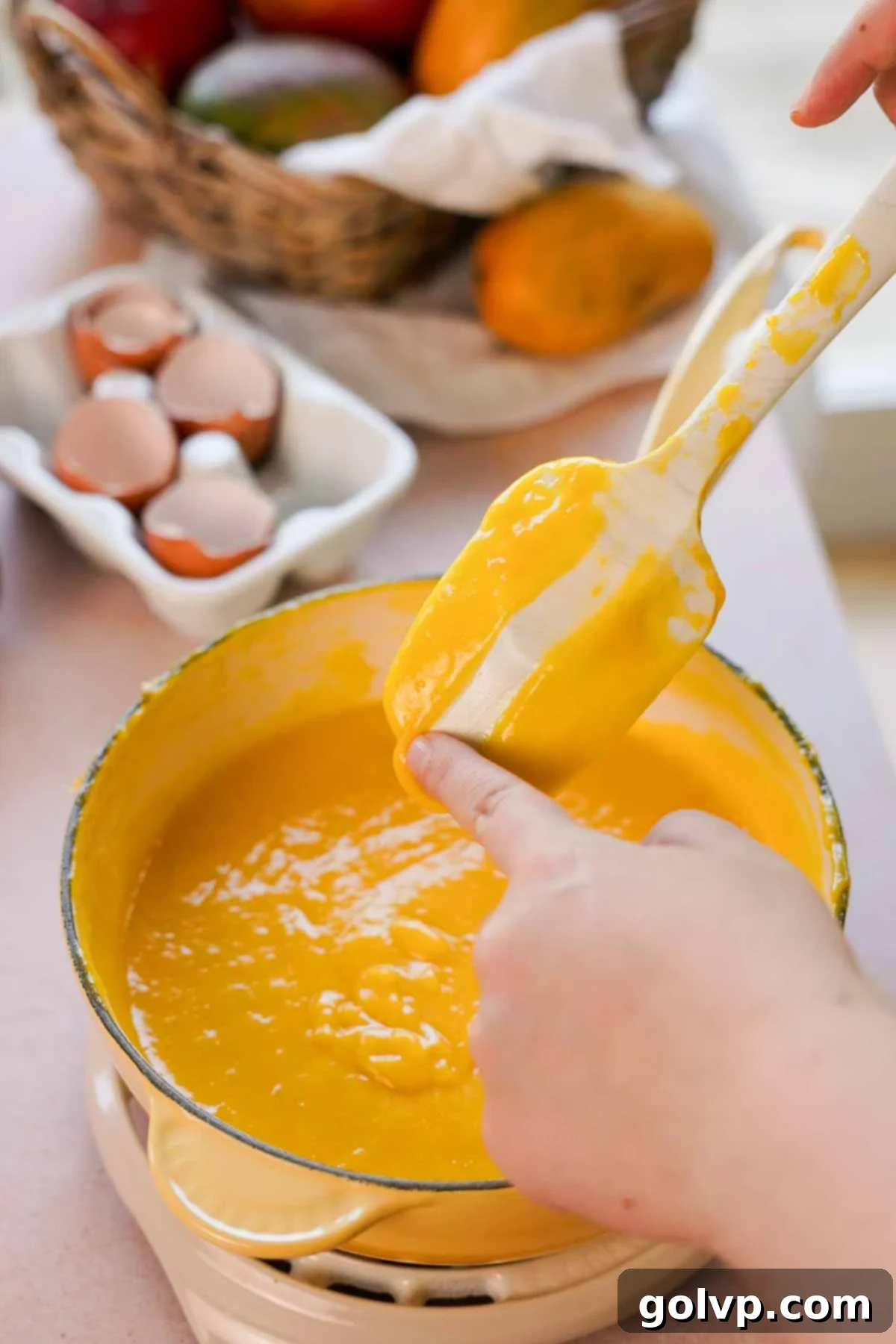
Step 3: Once the mango curd has thickened to the desired consistency and is bubbling gently, immediately remove the saucepan from the heat. Add the unsalted butter directly into the hot curd. Stir continuously until the butter is completely melted and smoothly incorporated into the curd, giving it a glossy sheen and extra richness.
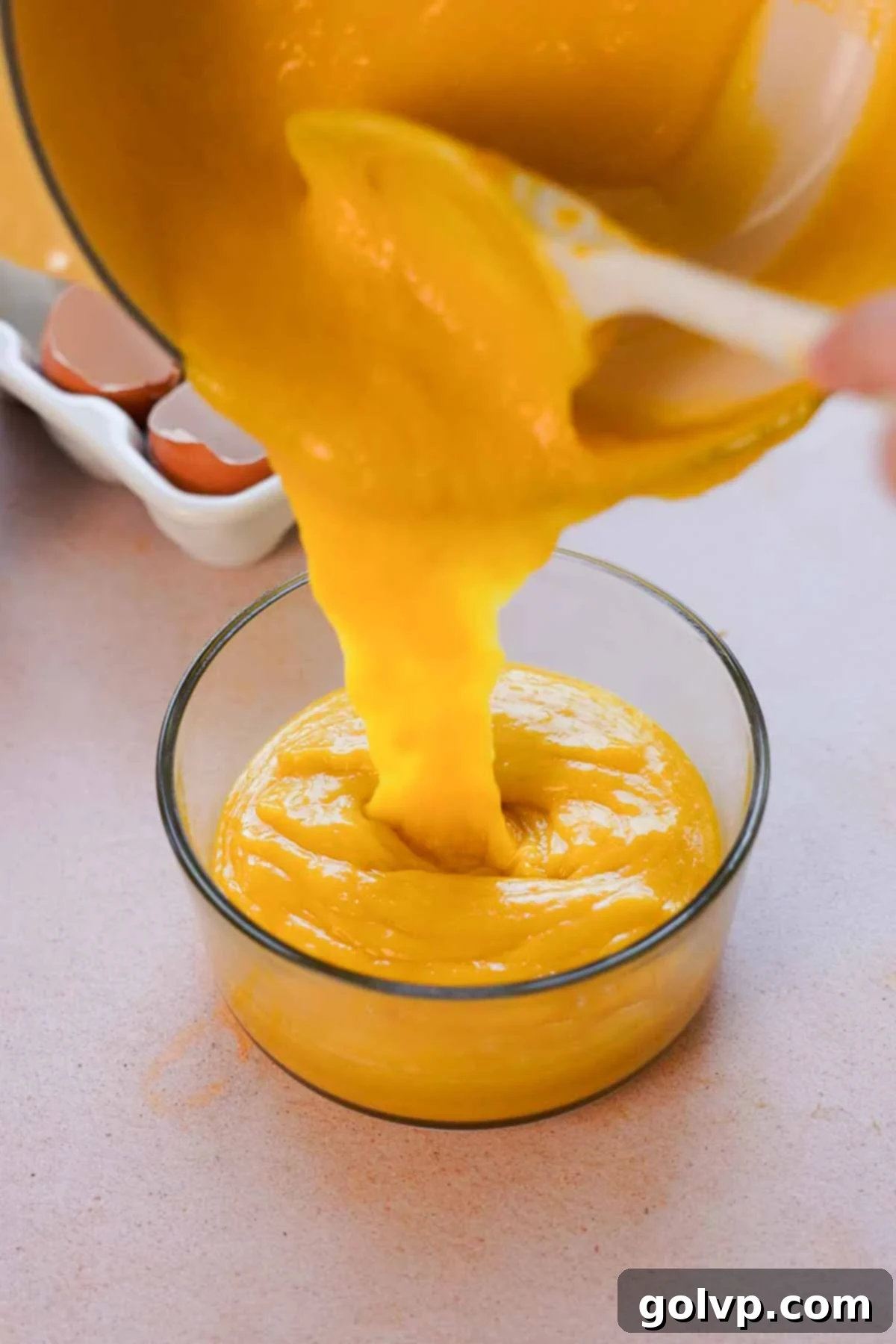
Step 4: Transfer the freshly made mango curd into a clean, non-metal container. This is important to prevent any metallic aftertaste from developing due to the curd’s acidity. Cover the surface of the curd directly with plastic wrap to prevent a skin from forming as it cools. Place the container in the refrigerator to chill thoroughly, which will allow it to fully set and thicken further, developing its vibrant flavor.
Mango Tiramisu Filling
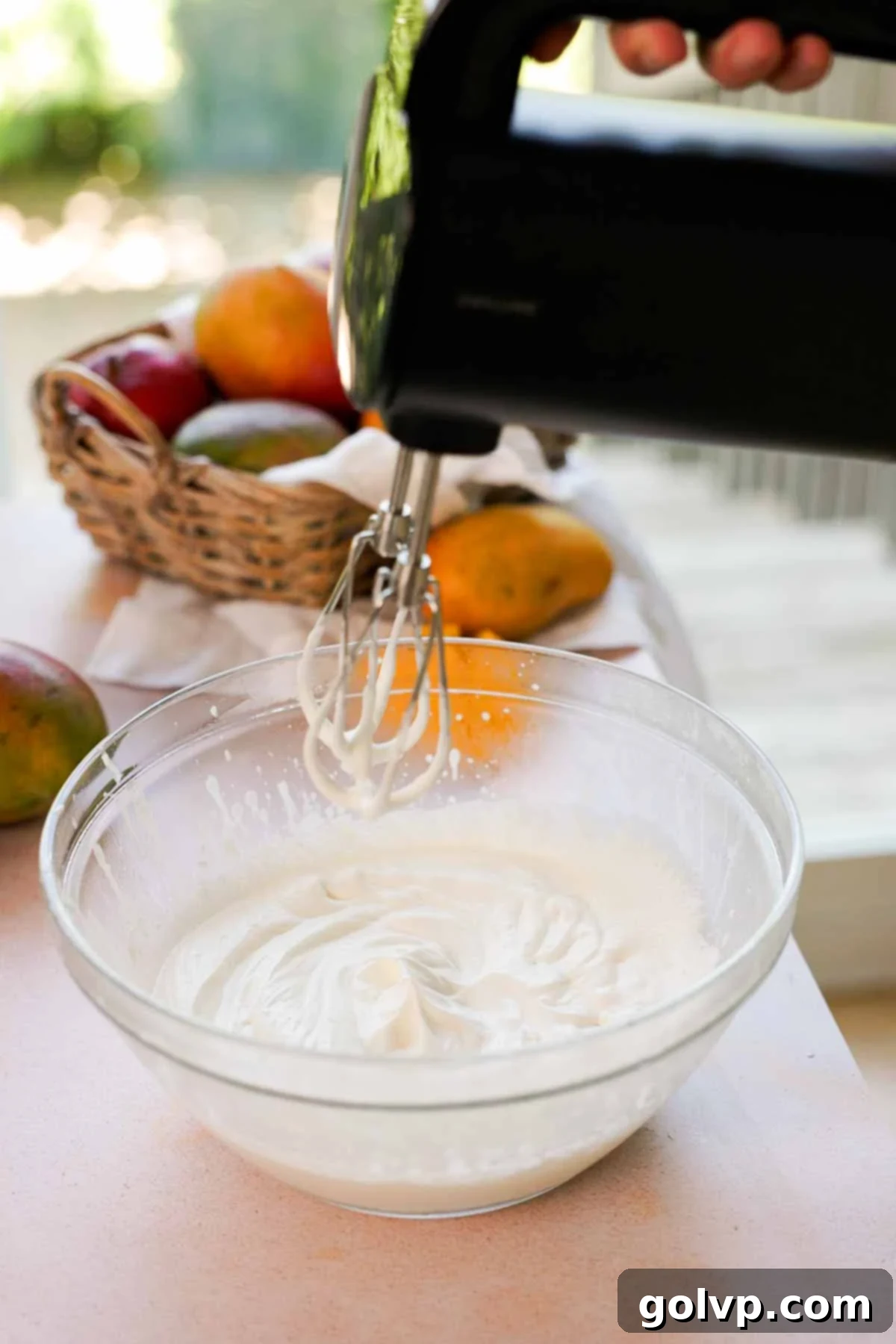
Step 1: Ensure your heavy whipping cream is thoroughly chilled for optimal results. Pour the cold cream into a large mixing bowl or the bowl of a stand mixer fitted with a whisk attachment. Begin whipping the cream on medium-high speed. Continue to whip until the cream forms soft peaks, meaning that when the whisk is lifted, the peaks gently droop rather than holding their shape firmly. Be careful not to over-whip at this stage.
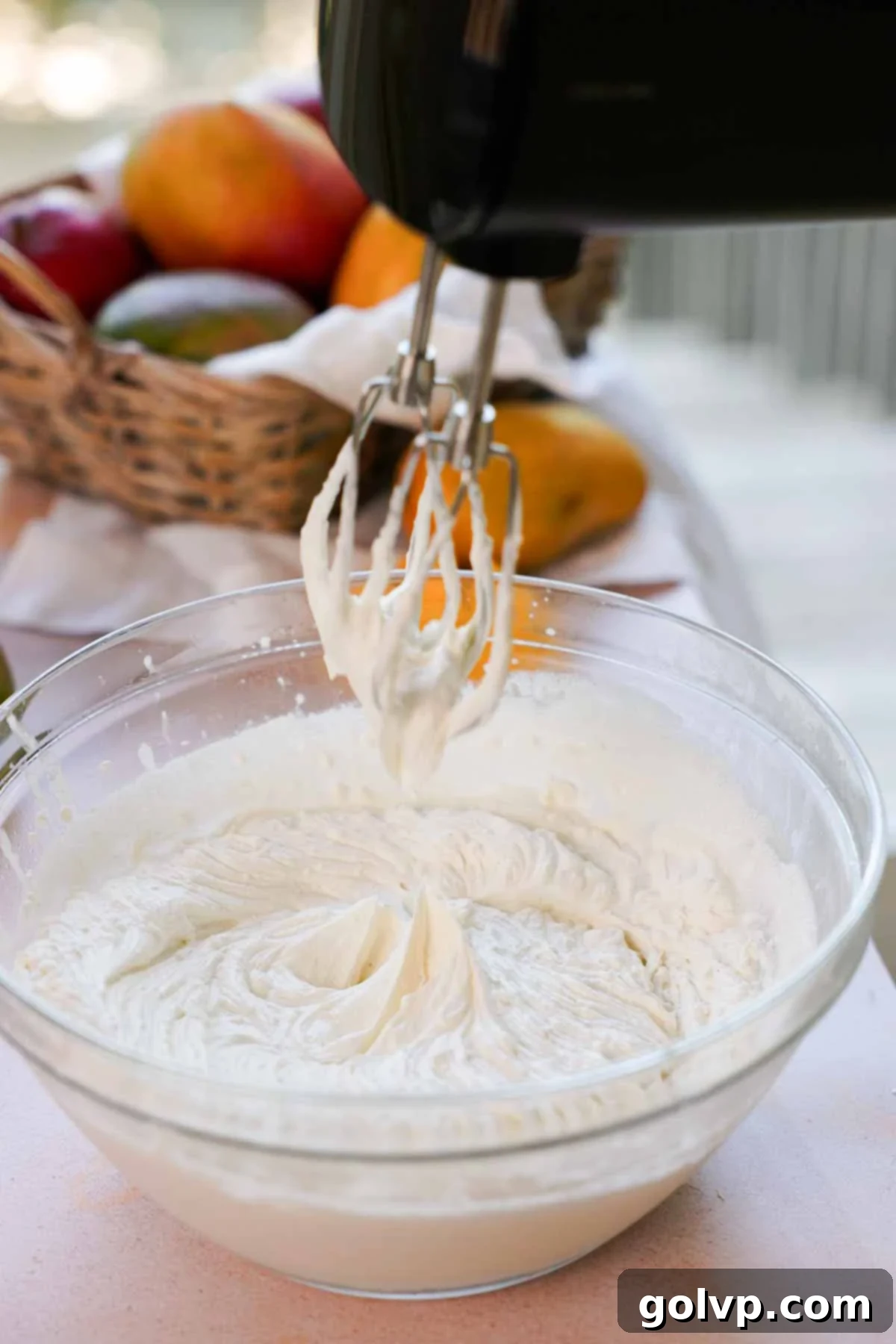
Step 2: Before adding the mascarpone cheese, give it a quick stir in its container to break it up and soften it slightly. This makes it much easier to incorporate smoothly into the whipped cream without clumping. Add the mascarpone cheese, vanilla (extract or paste), and the remaining pinch of sea salt to the bowl with the soft-peaked whipped cream. Continue whipping on medium speed until the mixture reaches stiff peaks. At this point, the cream should hold its shape firmly when the whisk is lifted. Be vigilant and stop mixing as soon as stiff peaks are achieved to prevent over-whipping, which can cause the mascarpone to separate and become grainy.
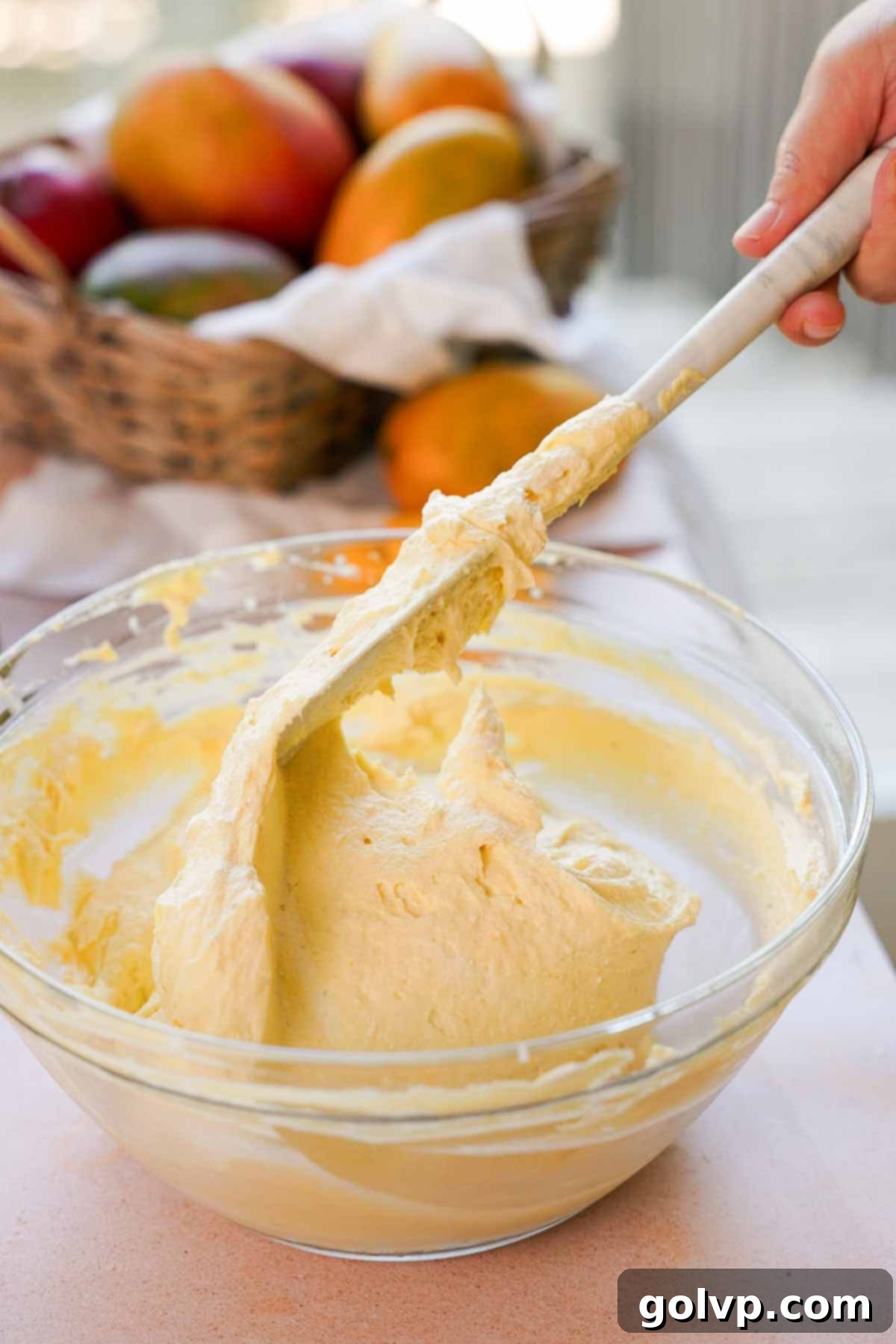
Step 3: Measure out one and a half (1 ½) cups of the chilled mango curd. Remember to keep the remaining half cup of mango curd reserved in the refrigerator for the final topping. Gently add the measured mango curd into the whipped mascarpone cream. It’s perfectly fine if the curd isn’t completely chilled and is at room temperature; this can even make it easier to fold. Using a spatula, carefully fold the mango curd into the mascarpone cream until just combined, taking care not to deflate the airy texture of the cream. Set this luscious mango tiramisu filling aside, ready for assembly.
Vanilla Milk Soak and Assembly
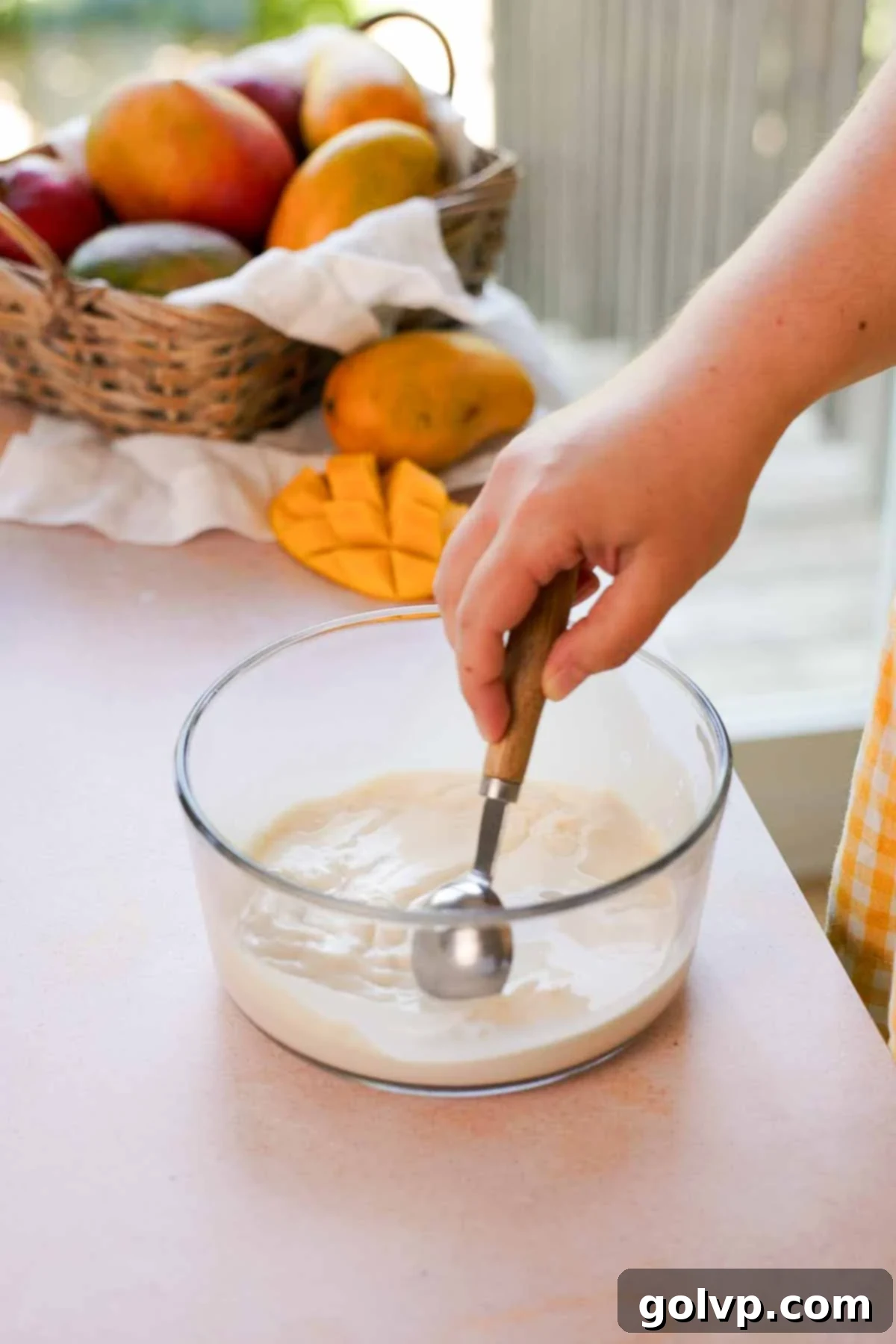
Step 1: In a wide, shallow soup bowl, combine the milk, granulated sugar, and vanilla extract. Whisk thoroughly until the sugar is completely dissolved, creating a fragrant vanilla milk soak. Now, it’s time to prepare your ladyfingers. For a truly decadent, super moist “tres leches” style tiramisu, gently dip each ladyfinger into the vanilla milk and let it soak for approximately 5 seconds, until it feels noticeably heavy and fully saturated. If you prefer a more classic tiramisu with a slightly less moist texture, simply dunk each ladyfinger into the milk and immediately remove it. Arrange the soaked ladyfingers in a single, even layer at the bottom of your chosen tiramisu or casserole dish.
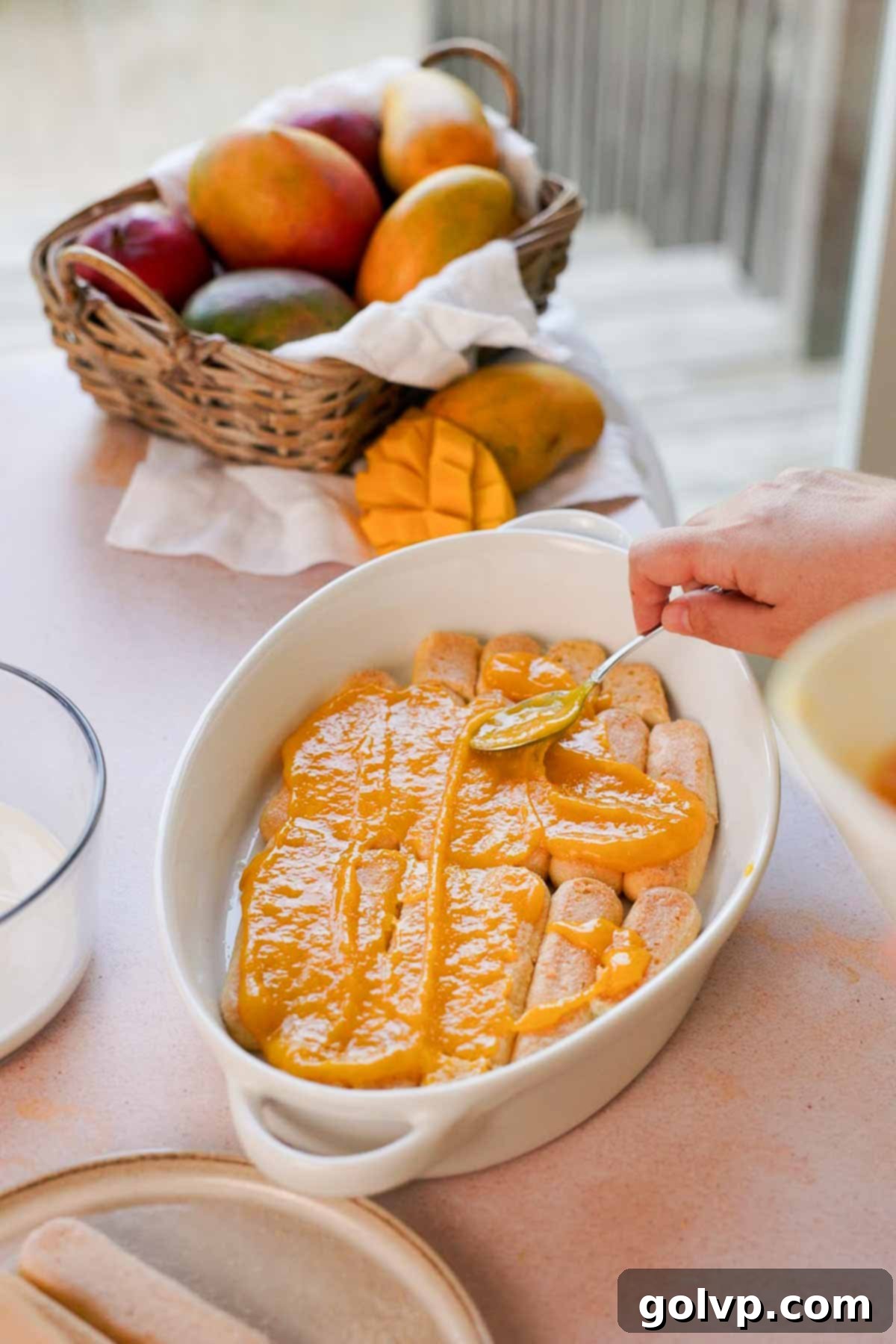
Step 2: Once your first layer of ladyfingers is in place, take half of the *reserved mango puree* (this is the puree, not the curd) and spread it evenly in a thin layer over the ladyfingers. This adds another burst of pure mango flavor and moisture. Next, carefully spoon half of the prepared mango tiramisu filling on top of the mango puree layer. Gently spread the filling all the way to the edges of the dish, creating a smooth and uniform layer. Take your time to ensure even distribution for a beautifully structured dessert.
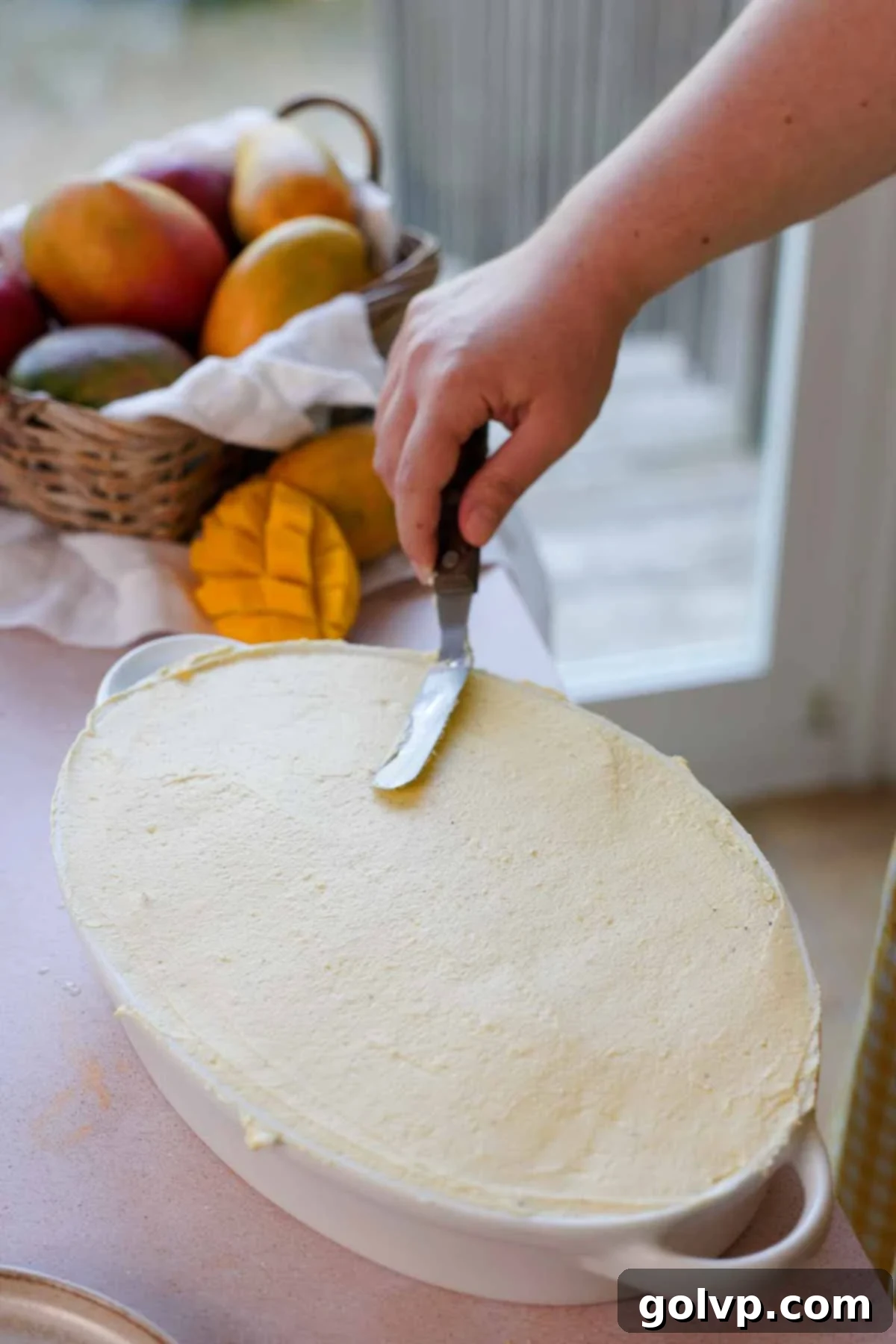
Step 3: Repeat the layering process. Add another complete layer of milk-dipped ladyfingers over the filling. Follow this with the remaining half of the mango puree, spreading it evenly. Finally, gently top with the rest of the mango tiramisu filling, smoothing the surface with a spatula for an elegant finish. Once all layers are assembled, cover the dish tightly with plastic wrap. This tiramisu absolutely requires time to set and for the flavors to meld, so refrigerate it for a minimum of 6 hours, or ideally, overnight. This chilling period is crucial for the cream to set beautifully and for the ladyfingers to fully absorb the moisture, ensuring a perfect, sliceable consistency.
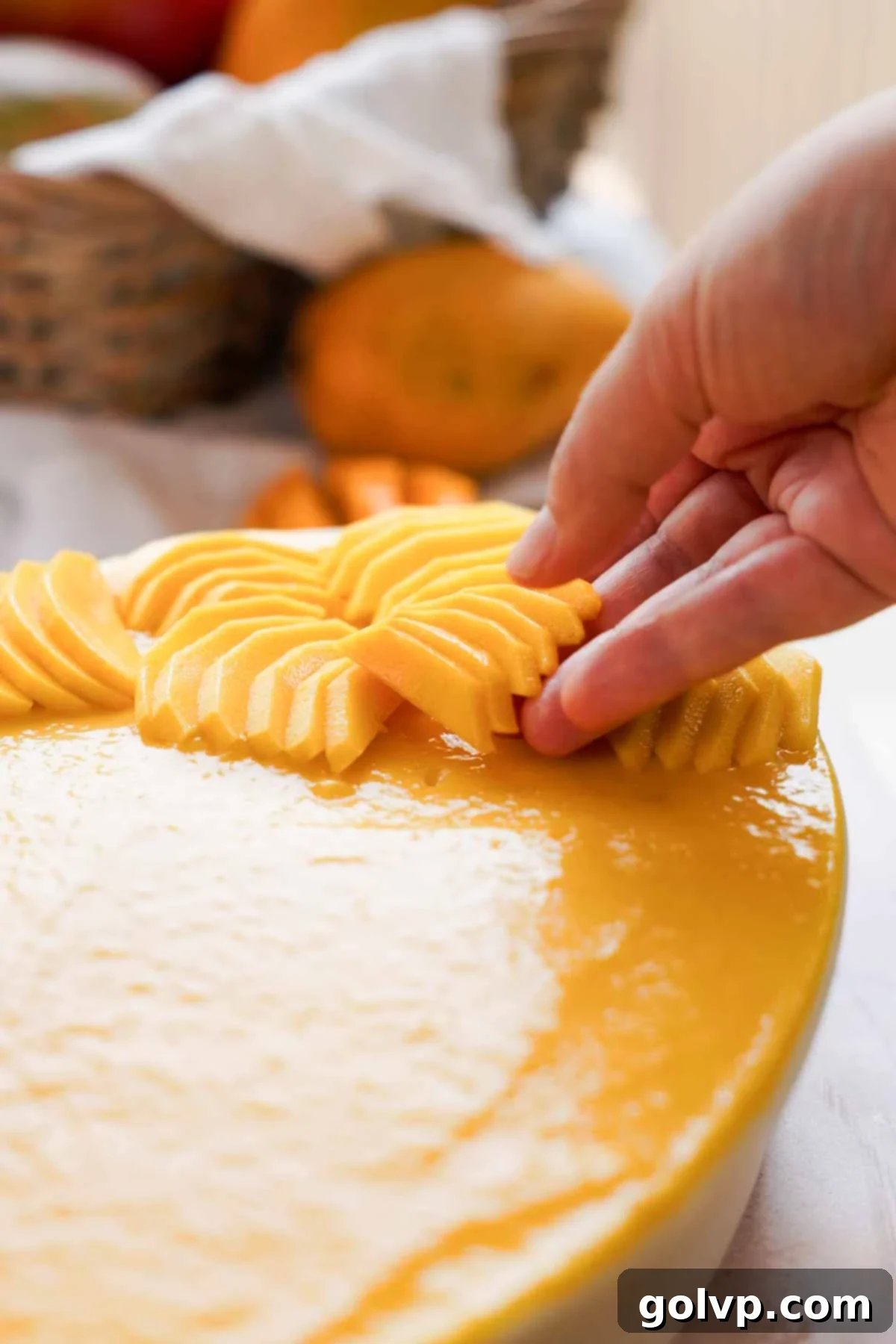
Step 4: Just before you’re ready to serve this stunning dessert, retrieve the reserved mango curd from the refrigerator. Spread it gently and evenly over the top layer of the tiramisu, creating a glossy, intensely flavored finish. For an exquisite presentation, decorate the top with thinly sliced, peeled fresh mango pieces. If you wish to add an extra touch of elegance and visual appeal, scatter a few edible flowers over the mango. These final touches not only enhance the beauty of the tiramisu but also highlight its tropical essence, making it a truly show-stopping centerpiece.

✔️ Expert Tiramisu Tips for Perfection
Achieving the perfect mango tiramisu requires a few key insights. Follow these expert tips to ensure your dessert turns out flawless every time:
- Use a Coated or Non-Metal Saucepan for Curd and Puree: This might seem like a small detail, but it makes a significant difference. The acidity present in the mango and lemon can react with un-coated metal saucepans, potentially imparting an undesirable metallic aftertaste to your delicate mango puree and curd. To preserve the pure, vibrant flavors of the mango, always opt for a non-metal or enamel-coated saucepan for these components.
- Do Not Skip Reducing the Mango Mixture: This is a crucial step for a reason. I’ve experimented with making mango curd without first reducing the mango mixture, and the results were consistently disappointing. The curd lacked the intense, bright mango flavor we’re aiming for and often developed an unappetizing metallic undertone. Reducing the mango concentrates its natural sugars and flavors, transforming it into a rich, aromatic base that is absolutely essential for a truly vibrant mango tiramisu. It’s an extra 10 minutes that pays dividends in flavor!
- Avoid Over-Whipping the Cream After Adding Mascarpone: This is perhaps the most critical tip for a perfectly creamy filling. When you introduce the mascarpone cheese to the whipped cream, continue mixing only until stiff peaks form. The moment you see those firm, stable peaks, stop mixing immediately. Mascarpone cheese is very delicate, and over-whipping it can cause its fat and liquid components to separate, turning your beautiful, fluffy cream filling into a grainy, liquid mess that cannot be salvaged. Vigilance is key here!
- Customize the Moistness of Your Tiramisu: The beauty of this recipe lies in its adaptability to your personal preference for texture. I personally adore a super milky, “tres leches” style tiramisu, which is why I recommend thoroughly soaking the ladyfingers until they’re heavy with vanilla milk. If you prefer a tiramisu that is less “juicy” and has a firmer bite, simply dip the ladyfingers very briefly into the milk, just enough to moisten them without saturating completely. Adjust the soaking time to achieve your ideal consistency.
- Chill the Tiramisu for at Least 6 Hours (or Overnight): Patience is a virtue when making tiramisu. This extended chilling period is non-negotiable for several reasons. Firstly, it allows the mascarpone cream to set beautifully, ensuring clean, elegant slices. Secondly, it provides ample time for the ladyfingers to fully absorb the vanilla milk and mango puree all the way to their centers, achieving a uniformly soft texture. Most importantly, chilling allows all the distinct flavors – the tangy mango curd, the sweet puree, the rich mascarpone, and the vanilla-infused ladyfingers – to meld and develop into a harmonious, complex, and utterly perfect tiramisu. Resist the urge to cut corners on chilling time for the best possible result!
🥄 Make Ahead and Storage Tips for Mango Tiramisu
Tiramisu is an ideal make-ahead dessert, as it absolutely benefits from ample time in the refrigerator to set and allow its flavors to fully meld. This makes it perfect for entertaining or preparing in advance for special occasions, reducing stress on the day of your event. The good news is that not only the finished dessert but also several of its components can be prepared ahead of time, saving you valuable prep time.
Mango Puree and/or Mango Curd: Both the mango puree and the mango curd are excellent candidates for advance preparation. You can easily make either or both a day or two before you plan to assemble the tiramisu. Simply store them in separate airtight containers in the refrigerator. This allows the flavors to deepen and ensures they are perfectly chilled and ready when you are. Just be sure to bring the curd to room temperature or slightly warm it if the recipe calls for it to be incorporated that way.
Finished Mango Tiramisu: Once fully assembled and chilled, your mango tiramisu will keep beautifully in the refrigerator for up to 4 days, provided it is tightly covered with plastic wrap to prevent it from absorbing any other odors and to maintain its moisture. For longer storage, this tiramisu freezes exceptionally well. You can either freeze the entire dish (if it’s freezer-safe and well-wrapped) or individual leftovers. Wrap the tiramisu tightly in several layers of plastic wrap, followed by a layer of aluminum foil, to protect it from freezer burn. It can be stored in the freezer for up to 2 months. To serve after freezing, transfer it to the refrigerator and allow it to thaw slowly overnight for the best texture and flavor. This ensures the cream remains smooth and luscious upon thawing.
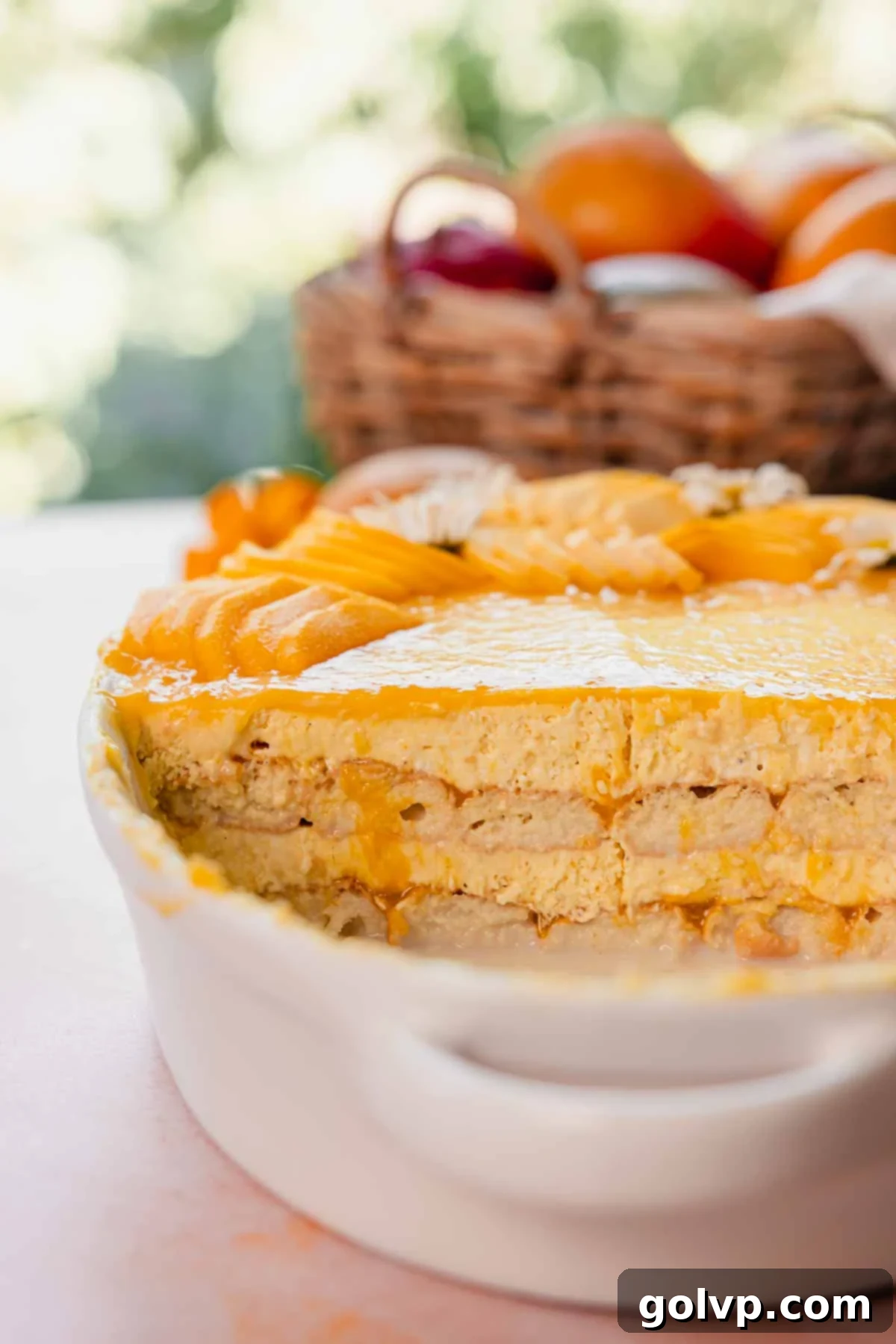
📖 Recipe FAQs for Mango Tiramisu
No, this mango tiramisu recipe is thoughtfully designed to be safe for everyone, as it does not contain any raw eggs. While traditional tiramisu often uses raw egg yolks or whites, in this recipe, the egg yolks are fully cooked as part of the mango curd. This cooking process gives the tiramisu that beloved richness and body found in classic versions, but without any associated concerns. Furthermore, we achieve a wonderfully light and fluffy texture by incorporating whipped heavy cream instead of raw egg whites. This innovative technique has been successfully used in other popular recipes, such as my viral lemon tiramisu and strawberry tiramisu, ensuring a delicious and worry-free dessert experience.
Converting this mango tiramisu to a gluten-free dessert is remarkably simple, as most of the components are naturally gluten-free. The key modification involves the ladyfingers. You will simply need to substitute traditional ladyfingers with a high-quality gluten-free version. Many specialty stores and even mainstream supermarkets now offer gluten-free ladyfingers or similar gluten-free sponge cookies that work perfectly in this recipe, absorbing the vanilla milk just as well as their traditional counterparts. The rest of the recipe remains unchanged, making it an accessible and delicious option for those with gluten sensitivities or dietary preferences.
While mascarpone cheese is truly the cornerstone of authentic tiramisu, contributing its unique mild, milky, and exceptionally creamy texture, it is technically possible to substitute it with cream cheese if you are in a pinch. However, it’s important to manage expectations, as mascarpone and cream cheese have distinct differences that will affect the final flavor and texture. Mascarpone boasts a higher milkfat content and a subtle, rich sweetness, whereas cream cheese tends to be firmer and has a more pronounced tart flavor. If using cream cheese, ensure it is softened to room temperature before mixing to avoid lumps. While it will still produce a delicious dessert, it will impart a tangier profile and a slightly different mouthfeel compared to the luxuriousness of mascarpone.
While the idea of layering this tiramisu as a traditional cake might be appealing, it’s important to understand that this recipe was specifically designed for serving out of a casserole or similar dish, where its more pudding-like, spoonable consistency can shine. Tiramisu, by nature, is meant to be a soft, creamy dessert rather than a structurally firm cake. If you attempt to layer it as a freestanding cake, it may lack the necessary structural integrity and could be prone to collapsing or being difficult to slice neatly. For the best experience and presentation, sticking to a dish that allows for scooping or slicing direct from the container is highly recommended.
This is a common and understandable question! The reason we advise against mixing mango puree directly into the milk for soaking the ladyfingers is due to a natural reaction. When mango puree and milk are combined and allowed to sit, the acidity in the mango tends to cause the milk to thicken, almost curdling it like buttermilk. This results in a much thicker, somewhat viscous mixture that makes it incredibly difficult for the ladyfingers to properly absorb the liquid and flavor evenly. Instead, by dipping the ladyfingers in simple vanilla milk and then spreading a distinct layer of mango puree on top, you achieve a much better result. This method ensures the ladyfingers become perfectly moist with milky goodness, while also providing a clear, gooey, and intensely flavorful layer of mango puree. It’s a technique that yields superior texture and a more pronounced flavor experience overall!
🥭 More Irresistible Mango and Tiramisu Recipes to Explore
If you’ve fallen in love with the vibrant flavors of this mango tiramisu, you’re in for a treat! The world of mango desserts is rich and diverse, offering a plethora of ways to enjoy this tropical fruit. Similarly, tiramisu, with its adaptable structure, can be transformed with an array of exciting flavors beyond coffee. Here are some other delightful recipes featuring mango or a creative twist on tiramisu that you might enjoy adding to your baking repertoire:
- Mango Crepe Cake with Easy Homemade Crepes
- Lemon Tiramisu with Lemon Curd
- Mango Coconut Swiss Roll Cake
- Mango Cupcakes with Mango Filling
Did you make this recipe? We would absolutely love to hear about your experience! Please take a moment to rate this recipe and share your thoughts in the comments section below. Your feedback is invaluable to us and helps other home bakers. Don’t forget to share your beautiful creation on Instagram and tag @flouringkitchen so we can admire your work. And for even more delicious recipe ideas and inspiration, be sure to follow us on Pinterest to save your favorites!
📖 Recipe
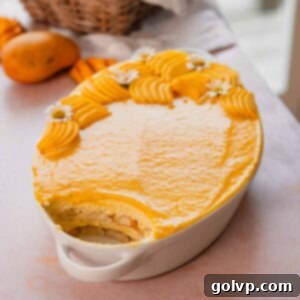
Mango Tiramisu
MaryEquipment
- electric mixer
- 8” by 11” oval dish or any non-metal dish of similar size
Ingredients
Mango Puree
- 4 cups mango fresh or frozen, 670g
- ¼ cup granulated sugar
- ¼ cup water
Mango Curd
- 4 large egg yolks
- ½ cup granulated sugar
- 2 tablespoons lemon juice
- ⅛ teaspoon sea salt
- 1 ½ cup mango puree
- ½ cup unsalted butter
Mango Tiramisu Filling
- 1 ½ cup heavy whipping cream chilled
- 1 lb mascarpone cheese chilled, 450g
- 1 tablespoon vanilla bean paste
- ⅛ teaspoon sea salt
- 1 ½ cup mango curd room temperature or chilled
Vanilla Milk Soak and Assembly
- 2 cups milk whole milk is best but you could use your milk of choice
- ¼ cup granulated sugar
- 1 tablespoon vanilla extract or vanilla bean paste
- 36 ladyfingers amount may vary according to the size of your dish, 300g
- 2 fresh mangos for decorating
- 5 edible flowers for decorating (optional)
Instructions
Mango Puree
- Cut along the sides of the mango pit, removing the two fleshy cheeks. Score the flesh of each cheek in a grid pattern, making sure not to cut through the skin. Push the center out to turn each mango cheek inside out. Slice the cubes off the skin with a sharp knife.4 cups mango
- Measure out 4 cups of peeled and cubed mango and transfer them into a saucepan. Add ¼ cup of sugar and ¼ cup of water, stir, and bring to a simmer on medium-low heat.¼ cup granulated sugar, ¼ cup water
- Simmer, stirring frequently until it thickens to a jam like consistency and darkens slightly in color, this will take about 10 minutes. You should now have 2 cups of mango.
- Blend the mango with an immersion blender, smoothie blender, or food processor until smooth. If you notice that there are fibers in the puree, I recommend straining it for a smooth finished product. Set aside.
Mango Curd
- Combine egg yolks, sugar, lemon juice, and salt in a medium saucepan. Stir together until smooth.4 large egg yolks, ½ cup granulated sugar, 2 tablespoons lemon juice, ⅛ teaspoon sea salt
- Measure and add 1 ½ cups mango puree (reserve the remaining ½ cup for later) to the saucepan and stir. Cook on low heat, stirring frequently to prevent burning, until it starts bubbling.1 ½ cup mango puree
- Once it starts bubbling and thickens, remove from the heat. Add butter and stir until the butter melts.½ cup unsalted butter
- Transfer the curd into a non-metal container to cool in the refrigerator.
Mango Tiramisu Filling
- Pour the cold cream into a large bowl or standmixer. Use an electric mixer with a whisk attachment and whip the cream to soft peaks.1 ½ cup heavy whipping cream
- Stir the mascarpone cheese in the container to break it up. This makes it easier to blend. Add the mascarpone cheese, vanilla, and salt into the whipped cream and whip to stiff peaks.1 lb mascarpone cheese, 1 tablespoon vanilla bean paste, ⅛ teaspoon sea salt
- Measure 1 ½ cups of mango curd (reserve the remaining ½ cup in the refrigerator for the top of the tiramisu). Add 1 ½ cups of mango curd into the whipped mascarpone cream. It’s ok if it’s at room temperature and not fully chilled. Fold together gently.1 ½ cup mango curd
Vanilla Milk Soak and Assembly
- Combine milk, sugar, and vanilla extract in a wide soup bowl. Stir to dissolve the sugar.2 cups milk, ¼ cup granulated sugar, 1 tablespoon vanilla extract
- Dip a ladyfinger into the vanilla milk and lay out in a single layer in a tiramisu/ casserole dish. For a super moist tres leches style tiramisu, dip the ladyfingers in the milk and take them out when they feel heavy, about 5 seconds each. For a classic, slightly moist tiramisu, dunk the ladyfingers in the milk and immediately take them out.36 ladyfingers
- Spread half of the reserved mango puree (not mango curd!) in a thin layer on top of the ladyfingers. Transfer half of the mango tiramisu filling on top and spread it out to the edges.
- Add another layer of dipped ladyfingers, the remaining mango puree, and remaining filling on top. Smooth it with a spatula, cover, and refrigerate for at least 6 hours or overnight.
- Before serving, add the rest of the mango curd on top and spread until smooth. Then, decorate with peeled and thinly sliced mango and edible flowers (optional).2 fresh mangos, 5 edible flowers
Notes
- If you have one, use a coated or non-metal saucepan to prevent a metal aftertaste in the mango puree and curd.
- Don’t skip reducing the mango mixture for a flavorful tiramisu
- Don’t overwhip the cream after adding the mascarpone cheese
- Decide how moist you want the mango tiramisu to be. For a tres leches style, dunk the ladyfingers until they’re soaked and heavy. For a less moist style, dip the ladyfingers briefly.
- Chill the tiramisu for at least 6 hours (preferably overnight) in the fridge for it to set perfectly.
